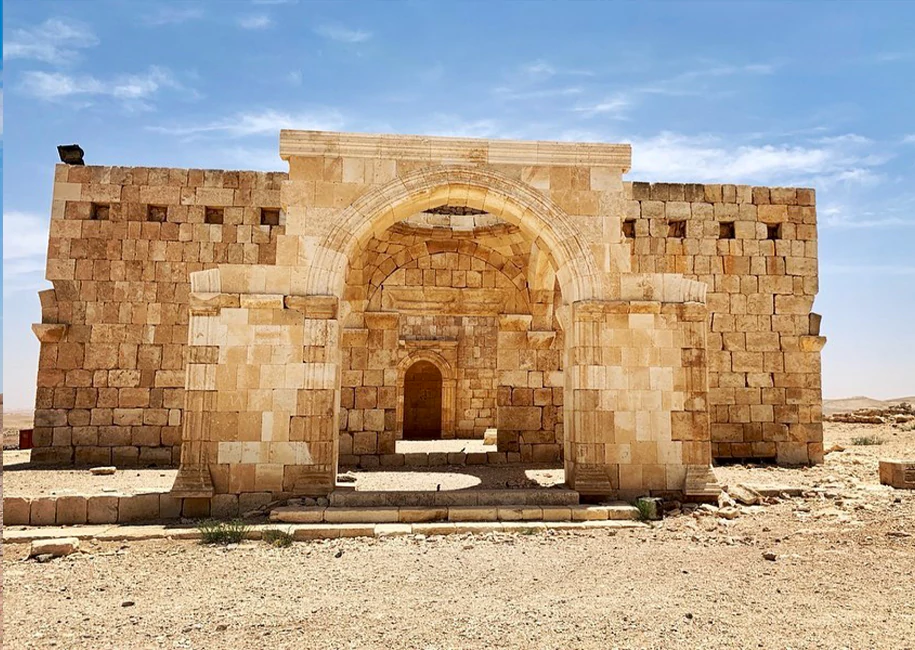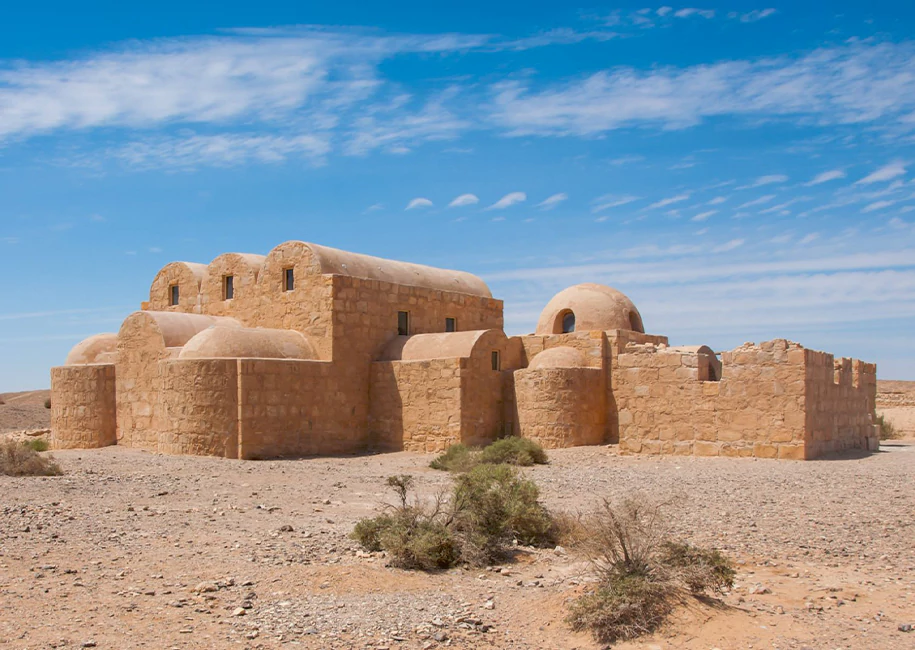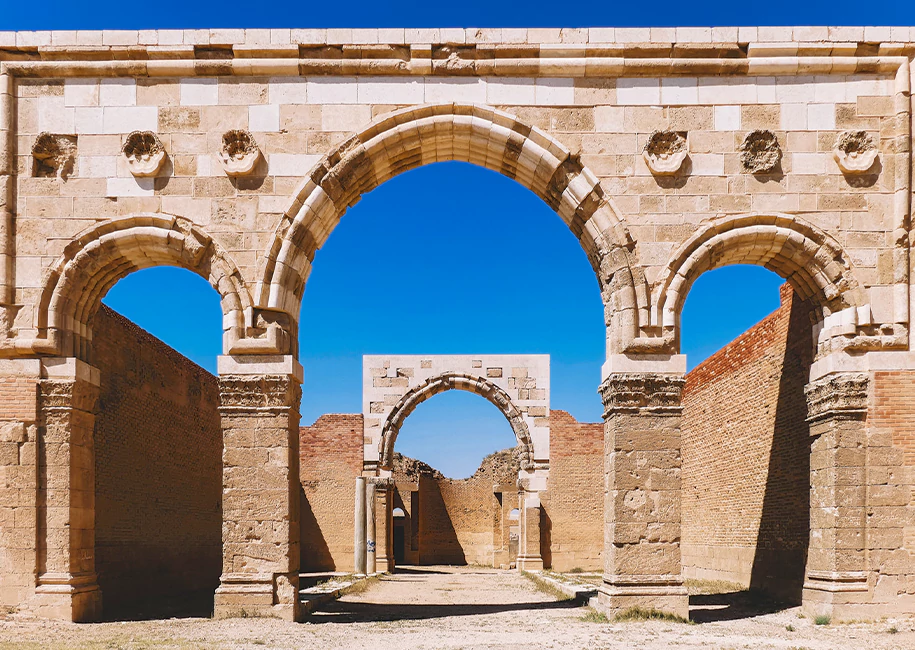
4 Desert Castles
1. Qasr Al Halabat
During the Umayyad dynasty, novles and wealthy families built small castles in semi-arid regions to serve as thier country estates or hunting lodges. For the Ummayad aristocracy, hunting was a favoured pastime and these desert castles became important places of relaxation and entertainment. In Arabic, these desert castles are known as qusur or sing. They were often built close to a water source or adjacent such as a natural oasis, and frequently sited along important trading routes, such as the ancient trade routes connecting Damascus with Medina and Kufa. Qasr Burqu' is one of the earliest examples of a desert castle.

This castle was built of limestone basalt trimmed stones, some bearing Latin inscriptions, which is square in shape, with a length of 44 m. Square towers were erected in its corners, which protrude from the thickness of the side walls by (2.5 m). An open pit in which a reservoir to collect rain water from the roof of the rooms located in the eastern side.
2. Qasr Al- Harranah
Al-Harranah Palace, or as some call it the “Kharrana Palace” is an Umayyad palace located in the Jordanian desert along the international road heading to Azraq, 65 kilometers east of Amman, and 659 meters above sea level. It was called the Harrana Palace, as it is located in Harrana, where thousands of granite stones are strewn on its surface, which is called the Harra, and this is often called the Harrana Palace, not the Kharana.

Al-Hurrana Palace is square in shape, with a length of 35 meters. What distinguishes the Harrana Palace is that it still retains its entire body except the northern part of it, which was affected by the factors of erosion and natural erosion, as the plaster fell from the outside, so building materials that consisted of soft sandstone and milk came from local clay as well. Evidence indicates that Al-Harnah Palace is the only Umayyad desert palace in Jordan that was established for defensive purposes, as it is a square-sided castle in every corner of which there is a round tower in addition to a half-round tower between each of the two angles on the walls of the palace cracks of light and ventilation and also to throw arrows in war situations.
3. Qasr Amra
The Umrah Palace or Qusayr Umrah is an Umayyad desert palace. It is listed on the UNESCO World Heritage Sites since 1985.
The palace consists of a rectangular reception hall with two contracts that divides it into three halls for each hall. A semicircular cellar. The central portico on the south side is connected to a large apse on its sides, two small rooms overlooking two gardens that were used for naps. The floor of the rooms and hall are decorated with mosaics representing floral motifs. As for the other rooms, they are covered with marble.

The palace has a bathroom adjacent to the reception hall consisting of three halls, two roofed with semi-circular vaults and the third roofed with a small dome. The bathroom, which is still in good condition, consists of three halls: cold, lukewarm and hot, the last one equipped with steam pipes. Attached to the bathroom is a large dressing room with two compartments.
The palace was also provided with a water network that passes under it. In the courtyard of the palace there is a water well with a depth of 40 meters and a diameter of 1.8 meters. The well accommodates 100 cubic meters of water that was filled from the valley of al-Butm when it rained and the water flowing in that valley, the water was raised from it by an old legs It is placed in a water tank next to the well and the water flows in two lines, one of which is heading to the inner courtyard to feed the fountain located to the left of the entrance and a line to supply the bathroom and bathroom room in clay tubes.
On the walls of the palace are holographic drawings and numerous engravings, whose topics range from scenes from hunting trips and animals that were found in the region in that era, including lions, tigers, deer and ostriches. At the end of the middle hallway of the reception hall, a mural of the caliph was found sitting on the throne, surrounded by a halo and accompanied by him, and there was a writing indicating the name of the caliph, but it was damaged without anyone being able to read it.
4. Qasr Al Mushatta
Mashta Palace is one of the Arab palaces built by the Umayyads in the Levant. The palace is located 32 km southeast of Amman. It was built by the Umayyad caliph Al-Walid bin Yazid in 744 AD. The palace is surrounded by a square wall of 144 meters in length, with 25 circular towers, except for the two entrance towers, they are semi-octagonal and the palace is located in Jordan in the Giza District.
The palace is divided into three wings, the middle wing is in turn divided into three sections, the northern and southern sections and includes the main buildings, while the middle section in the middle wing is an open courtyard. The northern wing was the seat of the caliph, while the southern wing is corridors, rooms and a mosque, and from it the only entrance that is decorated from the outside opens with an ornate facade.

Among the technical features of Qasr Al-Mashta are the carved limestone motifs at the tribal façade in which the entrance is located. This facade has been transferred to the Islamic Arts Department at Pergamon Museum, and it is noted that there are some artistic elements that resemble the motifs of the Dome of the Rock.
The walls of the palace were built of grilled bricks as a brick palace and surrounded by a square wall built of limestone, its length is approximately 150 meters, and in the fence there are 25 semicircular pillars to increase the cohesion between its parts, and the total area of the site inside the wall is approximately 22 dunums. Qasr Al-Mashta is located 30 km south of Amman, and it is believed that it was built by Al-Walid bin Yazid Al-Thani Bin Abdul-Malik in 743 (744 AD) (and this may be one of the reasons for the lack of completion of its construction). Historical sources mention that Al-Walid bin Yazid Al-Thani was exiled from the court of Caliphate when he was a prince, and he settled in the Jordanian Badia near the Al-Azraq oasis, and a short construction is attributed to him.
Azraq Oasis
Azraq is a region located in the east of the Hashemite Kingdom of Jordan. Azraq is known for a long time as a desert oasis rich in fresh and mineral water, and it has many monuments and tourist areas.
RSCN maintains an Azraq Lodge several kilometers away from the wetlands which features a gift shop, restaurant, 16 rooms in a 1940s British military hospital, and a reception area.
